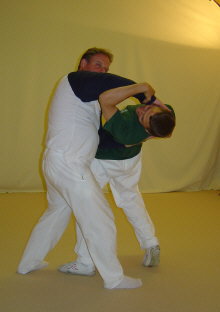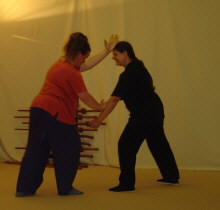Bagua Zhang
(also known as Pa Kua Chang)


The exact origins of Bagua Zhang are clouded in mystery. It is said to be the most Taoist of all the internal martial arts. Its name contains the holy number 8. It is also known as 8 step training. Ba means eight and in Bagua Zhang all eight points of the compass are visited in circular movements (all four main points of the compass as well as the four intermediate points). The well-known Bagua form symbol, an octagon, plays an important role in both Taoist philosophy and Feng Shui. The 8 trigrams, which have also given Bagua the name "8 Trigram Boxing" are important elements in the ancient book the I Ching or Book of Changes. The high-level energetic and philosophical relationship between the 8 trigrams and the individual palm changes are highly complex and not easy for a beginner to grasp..
Bagua Zhang is one of the most elegant but also one of the most difficult inner martial arts to learn. Unlike Tai Chi, where the movements are very slow and softly flowing, or Xingyi, where the movements are mainly fast, explosive and linear, Bagua Zhang training is extremely untypical and unique within the martial arts in that it consists of circle walking. In other words, students initially spend hours simply walking round in circles using special steps and various different arm and hand positions, all of which are aimed at the centre of the circle in which they are walking.
Training at elementary level begins with circle walking and the first of eight classic palm techniques. Then, in the course of training, the simpler forms are practised covering all 8 steps. This includes changes in direction and adjustments to arm and palm positions. Strictly speaking you take at least 7 steps in one direction and use steps 8 – 10 to change both direction and palm position in an ingenious sequence of steps.

At least 4 relatively simple elementary forms are practised in this way. Gradually the arm and palm changes become longer, more complex and more complicated. Each addition to the arm movements significantly improves coordination and orientation in and around the circle. To start with you are slightly confused and dizzy from all the walking round in circles. With practice, however, you grow accustomed to this state and you even grow to feel that something is missing if you don’t spend a few minutes each day walking in circles. It has a highly stimulating effect on the circulation and greatly strengthens the legs and lower back. There is often a considerable improvement in knee problems as a result of the special step technique used in Bagua.
Volker Jung teaches the 4 basic forms to start with and over the coming years the committed martial artist will have the chance to learn a wide diversity of forms named after various animals, as well as other so-called Linking Forms from the two young Chinese Sha family masters. For those of you interested in weapons there are the typical Bagua double 'Mandarin Duck' axes as well as a sword and sabre form.
A real highlight in the Sha family’s repertoire are the so-called Duillian Forms (partner forms), which are included in each of the inner martial arts taught by the family. Over the coming years Volker Jung will be organizing courses in which the lengthy Bagua partner form will be taught, once some basic and intermediate level forms have been mastered.

If your interest in Bagua has been awakened, please contact us.